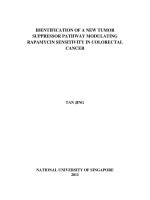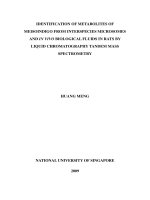Surveillance and species identification of Mycobacteria in cattle from abattoirs of Assam and Meghalaya
Bạn đang xem bản rút gọn của tài liệu. Xem và tải ngay bản đầy đủ của tài liệu tại đây (396.79 KB, 9 trang )
Int.J.Curr.Microbiol.App.Sci (2019) 8(2): 1197-1205
International Journal of Current Microbiology and Applied Sciences
ISSN: 2319-7706 Volume 8 Number 02 (2019)
Journal homepage:
Original Research Article
/>
Surveillance and Species Identification of Mycobacteria in Cattle from
Abattoirs of Assam and Meghalaya
Acheenta G. Barua1*, Koushik Kakoty1, Pranjal M. Nath1, Himangshu Raj2,
Jyoti Pawan Chutia2 and Pranab Koch2
1
Department of Veterinary Public Health, College of Veterinary Science,
Assam Agricultural University, Khanapara, Guwahati-781022, India
2
Veterinary officer, Govt. of Assam, India
*Corresponding author
ABSTRACT
Keywords
AFB, IFN-γ,
Mycobacterium
bovis, Necropsy,
PCR
Article Info
Accepted:
10 January 2019
Available Online:
10 February 2019
The study was carried out to investigate bovine tuberculosis and diagnostic potential of
IFN-γ assay and necropsy inspection in different abattoirs of Assam and Meghalaya,
including its species identification. A total number of 234 animals were screened by IFN-γ
and necropsy inspection. IFN-γ was performed according to kit procedures and carcasses
were inspected for any gross visible lesion. Species identification was confirmed by
biochemical test (viz. Nitrate reduction test, Pyrazinamidase test and Niacin detection test)
and PCR targeting pncA and oxyR gene. The inter-rater agreement (weighted kappa)
among different screening tests was analysed using standard software. Gross visual lesions
were found in 48 (20.51%) carcasses whereas 43 (18.38%) animals were reactive to IFN-γ.
Suspected 119 tissue samples were collected from 48 animals. Pre-culture stain revealed
83 (69.75%) and culture growths were from 96 (80.67%) tissue samples. Highest lesions
were recorded in lymph nodes (56.30%) followed by lungs (16.80%) and liver (8.40%).
Pre-scapular (38.80%) and retropharyngeal (26.86%) contribute more lesions than other
lymph nodes. The sensitivity and specificity of IFN-γ was 81.58 % and 98.29%
respectively. Very good Inter-rater agreements (kappa) were observed between IFN-γ,
culture and pre-culture stains and good agreement between IFN-γ and necropsy inspection.
Our results indicate visual inspection may serve as good screening method for tuberculosis
infected carcasses although IFN-γ assay before slaughter may give brief idea about the
infection. The study confirms the endemic status of bovine tuberculosis in these areas of
north east India.
Introduction
In many developing countries bovine
tuberculosis (BTB) is a major infectious
disease among domesticated animals and
certain captive wild animals. It is estimated
that M. bovis is responsible for about 5% of
all TB infection in human (Cosivi et al., 1998
and Michel et al., 2010). Farmers,
slaughterhouse workers, animal keepers at
zoo as well as veterinary professionals are at
high risk to the exposure of BTB infection
1197
Int.J.Curr.Microbiol.App.Sci (2019) 8(2): 1197-1205
through contact with infected livestock or
their carcasses (Elmonir and Ramadan, 2016).
India possesses more than 16% of world cattle
population. Cattles are also considered as
natural host of M. bovis. Milk from healthy
lactating cows had been reported to shed M.
bovis bacilli (Danbirni et al., 2010). Ingestion
of beef from infected cattle can be a major
threat to public health as cooking may not
always be an effective against M. bovis
infection (van der Merwe et al., 2009). In the
case of dairy milk however, pasteurisation
minimizes the risk of infection. In M. bovis
infected cattle, CD4 T-cells produces IFN-γ
leading to the activation of macrophage, with
CD8 T-cells greater involvement in the lysis
of infected cells (Skinner et al., 2003). Okafor
et al., (2013) documented that IFN-γ response
is sufficient to classify cattle as positive for
tuberculosis. Polymerase chain reaction
(PCR) of pncA and oxyR gene was evaluated
for species specification for M. bovis and M.
tuberculosis. As M. bovis is resistant to
pyrazinamide, species identification will also
help for treatment of individuals.
Abattoirs, butcher shops provide an ideal
environment as a monitoring point for the
screening of carcasses for BTB. Aerosol
exposure to M. bovis is considered to be the
most frequent route of infection of cattle, but
infection may be occurred by contaminated
material (Barua et al., 2016). Characteristic
tuberculous lesions occur most frequently in
the lungs, liver and lymph nodes.
The present study was undertaken for the
purpose to investigate the infection of BTB in
abattoirs, butcher shop and meat market in
some parts of Assam and nearby state of
Meghalaya. In this study, we also investigated
the efficiency of IFN-γ assay and necropsy
findings based on bacterial culture,
biochemical tests and polymerase chain
reaction (PCR) for species identification.
Materials and Methods
Study site and cattle breeds
The current study was carried out in different
abattoirs, butcher shop and meat market
(beef) located in various places of Assam and
nearby state Meghalaya. The slaughter
environment is mostly unhygienic and
unorganized. In Assam cattle are reared
mostly
for
milk
and
livelihood.
Predominantly local indigenous constitutes
about 60 % and others are jersey crossbred in
both the states.
IFN-γ assay
Blood samples were collected aseptically
before slaughter for IFN-γ assay. It was
performed according to kit procedures
(RayBio bovine IFN-gamma ELISA kit).
Briefly, bovine IFN-γ was used as a standard
at 30 ng/ml, 12 ng/ml, 4.80 ng/ml, 1.92 ng/ml,
0.768 ng/ml, 0.307ng/ml, 0.123 ng/ml, along
with the positive and negative controls (RPMI
1640). Samples were read at a wavelength of
450 nm to calculate optical density. A sample
was considered as positive when the
difference between mean optical density value
of a negative control with mean optical
density value of sample is equal or higher
than 0.100.
Gross necropsy
All the carcasses were inspected for any gross
visible lesion suspected of tuberculosis.
Organs and tissue samples were collected
from all the carcasses for further analysis. In
this study, an animal was considered positive
on necropsy if 1 or more lymph nodes or
other tissues contained focal or multifocal
abscesses or granulomas. Although some
samples with no visible lesions were also
processed further for tests.
1198
Int.J.Curr.Microbiol.App.Sci (2019) 8(2): 1197-1205
Pre-culture staining (PCS)
Statistical analysis
Ziehl-Neelson (ZN) staining for the detection
of acid-fast bacteria (AFB) was performed on
all tissue samples. A sample was considered
positive for tuberculosis if there was evidence
of granulomatous inflammation associated
with focal necrosis or mineralization and/or if
there was identification of AFB on the ZN
stain.
Data analysis was carried out in Microsoft
excel version 2010. Sensitivity and specificity
were calculated as per Bassessaret al., (2014).
The inter-rater agreement (weighted kappa)
among different screening tests were analysed
using MedCalc Statistical Software (trial
version 15.8 MedCalc Software bvba, Ostend,
Belgium; ; 2015).
Kappa values were interpreted according to
Altman (1991).
Mycobacterial
identification
culture
and
species
Results and Discussion
Fresh and stored tissue samples were
macerated and decontaminated using NALC
and inoculated on to Lowenstein Jensen (LJ)
media. Briefly, approximately 1g of tissue
exhibiting gross visible lesions was sliced and
homogenized and then subjected for
decontamination.
The supernatant was discarded and the pellet
formed re-suspended in 300µl of phosphate
buffered saline (140mM NaCl, 26mM KCl,
10.0mM Na2HPO4 and 1.7mM KH2PO4).
Then the re-suspended pellets were inoculated
in duplicates onto LJ slants (one incorporating
glycerol and the other pyruvate). LJ slants
were incubated at 37oC and observed weekly
for eight weeks. Using a sterile 0.1 µl plastic
loop, the re-suspended pellets were spread
and fixed at 80oC (for 10 min) onto a labelled
slide. The slides were subjected for staining
with modified ZN stain.
Biochemical analysis were performed for
species identification of mycobacteria as per
standard protocol, such as Nitrate reduction
test
(Kubica
and
Wayne,
1984),
Pyrazinamidase test (Wayne, 1974) and
Niacin detection test (Gadreet. al., 1995).
DNA was isolated from bacterial culture and
PCR was done targeting pncA and oxyR gene
as per De Los Monteros et al., (1998).
In the current study, we assayed IFN-γ in
animals before slaughter and necropsy tissue
samples with lesions suggestive of
mycobacterial infection from abattoirs,
butcher shop and meat market using ZN
microscopy and compared the results with
those of culture, biochemical tests and PCR.
A total of 234 animals were pooled from
slaughter house and butcher shop based on
their debilitating health condition. Only 43
(18.38%) showed reactive to IFN-γ (Table 1).
The sensitivity and specificity of IFN-γ was
81.58 % and 98.29% respectively (Table 2),
which is agreeable with Gormley et al.,
(2013) where sensitivity of IFN-γ varied
between 73.0 -100% and specificity with a
range of 85.0–99.6%.
However, because a few of the animal each
had more than one organ presenting lesions,
119 samples of suspicious organs were
obtained from 48 animals. In terms of organ
involvement, the majority lesions were found
in lymph nodes (67, 56.30 %) followed by
lungs (20, 16.80%) and liver (10, 8.40%)
respectively (Table 3), which is comparable
with Teklu et al., (2004) and Stefan et al.,
(2009). Out of 67 lymph nodes, prescapular
and retro pharyngeal lymph nodes contribute
more (Table 4). PCS revealed that, out of the
1199
Int.J.Curr.Microbiol.App.Sci (2019) 8(2): 1197-1205
48 carcasses disclosing suspicious lesions at
necropsy, 70.83% (34/48) furnished lesions
samples tested positive for AFB contributing
69.75% of total suspected samples. In terms
of the 119 individual organ sample analysed,
lymph nodes represented the highest number
of pre-culture stain positive samples, 42.85%
(51/119), followed by lung tissues, 15.12%
(18/119) and then liver 6.72% (8/119). For the
67 lymph nodes screened in PCS, prescapular
lymph nodes showed 35.82% (24/67) positive
for AFB followed by retro pharyngeal 20.89%
(14/67) (Table 4).
In terms of overall organ distribution (n =
119), the number of lesions in lymph nodes
was higher than lungs and liver but the
fractions of ZN positive samples out of each
organ category was different, e.g. in lung
tissue (90.0 % or 18/20) and liver (80.0% or
8/10) were higher than that in lymph nodes
(76.12% or 51/67). Low ZN-positive results
in the lymph nodes in this study may be due
to the low rate of survival of mycobacteria in
central caseation of lymph node (Cassidy,
2006) or instability of bacterial structure as a
result of some immune reactions that occur in
response to infection by mycobacteria
(Guitierrez et al., 1993)
All the suspicious 119 samples were
processed and inoculated onto LJ slants,
80.67% (96/119) grew successfully, 5.2% (n
= 3/119) were contaminated and 16.81%
(20/119) did not show any growths. In terms
of cultured tissue distribution, out of the 96
successful culture isolates obtained, 61 (or
51.26%) were from lymph nodes. This
finding was in consistent with many studies
(Aylate et al., 2013; Barua et al., 2016;
Shitaye et al., 2006; Youssef and Ahmed,
2014).
Table.1 Results of different screening methods for detection of mycobacteria infection in 234
animals
Visual lesions
(suspected)
pre culture stain
Culture
IFN-γ
Total
Positive
48 (20.51%)
Negative
186 (79.48%)
234
37 (15.81%)
39 (16.67%)
43 (18.38%)
197 (84.19%)
195 (83.33%)
191 (81.62%)
Table.2 Sensitivity and specificity of carcass inspection (necropsy), pre culture stain (PCS) and
IFN-γ based on culture and PCR as gold standard
Parameters
True Positive
True Negative
IFN-γ false Positive
IFN-γ False Negative
PCS false positive
PCS false negative
necropsy false positive
necropsy false negative
No. of animal
31
173
7
3
3
5
17
8
1200
Sensitivity
Specificity
81.58%
98.29%
91.18%
97.19%
64.58%
95.58%
Int.J.Curr.Microbiol.App.Sci (2019) 8(2): 1197-1205
Table.3 Distribution of various organs involved in mycobacteria infection. (n = 119)
Organs
Lung
Lymph node
Liver
Spleen
Pleura
Peritoneum
Uterus
Total
Suspected
lesions
PCS +ve
culture +ve
20 (16.80%)
67 (56.30%)
10 (8.40%)
7 (5.88%)
6 (5.04%)
5 (4.20%)
4 (3.36%)
119
18 (15.12%)
51 (42.85%)
8 (6.72%)
2 (1.68%)
2 (1.68%)
1 (0.84%)
1 (0.84%)
83 (69.75%)
19 (15.97%)
61 (51.26%)
10 (8.40%)
2 (1.68%)
2 (1.68%)
1 (0.84%)
1 (0.84%)
96 (80.67%)
Table.4 Distribution of different lymph nodes involved in mycobacteria infection
(n = 67)
lymph nodes
lesion +ve
pcs +ve
culture +ve
6 (8.95%)
Bronchial LN
9 (13.43%)
Messenteric LN
26 (38.80%)
Prescapular LN
18 (26.86%)
Retro Pharyngeal
LN
Supra mammary LN 5 (7.46%)
3 (4.48%)
Mediastinal LN
67
Total
5 (7.46%)
5 (7.46%)
24 (35.82%)
14 (20.89%)
6 (8.95%)
8 (11.94%)
26 (38.80%)
18 (26.86%)
2 (2.98%)
1 (1.49%)
51 (76.12%)
2 (2.98%)
1 (1.49%)
61 (91.04%)
Table.5 Inter rater agreement (kappa) between different screening methods
Lesion positive
Lesion negative
PCS positive
PCS negative
IFN-γ positive
IFN-γ negative
PCR
+ve
PCR
-ve
kappa
IFN-γ
+ve
IFN-γ
-ve
kappa
PCS
+ve
PCS
-ve
kappa
31
8
34
5
36
3
17
178
3
192
7
188
0.648
33
10
35
8
15
176
2
189
0.659
34
3
14
183
0.757
0.874
0.852
1201
0.849
Int.J.Curr.Microbiol.App.Sci (2019) 8(2): 1197-1205
Fig.1 Gross visible lesion of a) lung b) liver c) lymph node d) spleen e) peritoneum f) uterus
a)
b)
c)
d)
e)
f)
Fig. 2 Agarose gel electrophoresis showing presence of a) pncA (185bp) and b) oxyR (280bp)
gene in M. bovis (L1 and L3) but absent in M. tuberculosis (L2 and L4). Lane M indicates 100bp
marker
L4 L3
M
L2
L1
M
a)
L1
L2
L4
b)
Fig.3 Unhygienic and unorganized cattle slaughter environment
1202
L3
Int.J.Curr.Microbiol.App.Sci (2019) 8(2): 1197-1205
Out of the 234 carcasses, 37 showed positive
by pre-culture stain of which in 3 animals no
visible lesions observed. This may indicate
that ZN pre culture microscopy is quite good
at correctly identifying samples.
All the culture positive samples showed
negative for nitrate, pyrazinamidase, niacin
test which indicates positive for M. bovis. In
PCR, all the culture samples were found to be
positive for BTB, showing band at 185bp of
pncA and 280bp of oxyR gene (Fig. 2)
specific for M. bovis, which is in agreement
with Baruaet al., (2017).
Moreover, in the present study the inter ratter
agreement (kappa) between PCR and PCS
(0.874), IFN-γ and PCS (0.849), PCR and
IFN-γ (0.852) were found to be very good.
Necropsy analysis showed a good agreement
(0.60-0.80) with PCR, PCS and IFN-γ (Table
5).
Acknowledgement
Authors are thankful to ICAR, New Delhi for
funding the “Outreach Project on Zoonotic
diseases” and Director of Research
(Veterinary) for necessary facilities to carry
out the research. Due acknowledgement is
also extended to the abattoir workers for
providing samples.
References
Altman, D.G. 1991. Practical statistics for
medical research, London: Chapman
and Hall.
Asseged, B., Woldesenbet, Z., Yimer, E. and
Lemma, E. 2004. Evaluation of Abattoir
Inspection for the diagnosis of
Mycobacterium bovis infection in cattle
at Addis Ababa Abattoir. Trop. Anim.
Health Prod. 36: 537-546.
Atiadeve, S. K., Gyamfi, O. K., Mensah, E.
M., Galyuon, I. K. A., Owusu, D.,
Bonsu, F. A., Bedzra, K. D. and Gyasi,
R. K. 2014. Slaughter surveillance for
tuberculosis among cattle in three
metropolitan abattoirs in Ghana. J. Vet.
Med. Anim. Health. 6: 198-207.
Aylate, A., Shah, S. N., Aleme, H. and
Gizaw, T. T. 2013. Bovine tuberculosis:
Prevalence and diagnostic efficacy of
routine meat inspection procedure in
Woldiya municipality abattoir north
Wollo zone, Ethiopia. Tropi. Ani. Healt.
and Product.45: 855–864.
Barua, A. G., Raj, H. and Goswami, C. 2016.
Slaughter house surveillance for
tuberculosis among cattle in Ri-Bhoi
district of Meghalaya. International
Journal of Veterinary Sciences and
Animal Husbandry. 1: 14-15.
Barua, A. G., Raj, H., Kumar, A., Barua,
C.C., Purkayastha, A. and Patowary, P.
2017. Diagonis of Mycobacterium bovis
infection in livestock using gamma
interferon assay and single intradermal
comparative tuberculin test in Assam
and Meghalaya. Indian J. Anim. Res.
51(4): 737-741.
Bassessar, V., Shrivastav, A. B., Swamy, M.
and Rokde, A. 2014. Comparison
between intradermal tuberculin skin
testing and interferon gamma ELISA
for diagnosis of bovine tuberculosis in
Jabalpur region. Indian J. Anim. Sci.84:
115–119.
Cassidy, J. P. 2006. The pathogenesis and
pathology of bovine tuberculosis with
insights from studies of tuberculosis in
humans and laboratory animal models.
Vet. Microbiol. 112: 151-161.
Cosivi, O., Grange, J. M., Daborn, C. J.,
Raviglione, M. C., Fujikura, T.,
Cousins, D., Robinson, R. A.,
Huchzermeyer, H. F., de Kantor, I. and
Meslin, F. X. 1998. Zoonotic
tuberculosis due to Mycobacterium
bovis in developing countries. Emerging
Infectious Diseases. 4: 59-70.
1203
Int.J.Curr.Microbiol.App.Sci (2019) 8(2): 1197-1205
Danbirni, S., Sackey, A. B. K., Ayo, J. O.,
Bawa, E. K., Kudi, A. C., Okayeto, S.
O. and Pewan, S. B. 2010. Exposure
and
Shedding
in
Milk
of
Mycobacterium bovis in dairy herds
using One-Step antigen rapid bovine
tuberculosis antibodies test and Ziehlneelsen stain. Vet. Res. 3: 38-42.
De Los Monteros, L. E. E., Galan, J. C.,
Gutierrez, S. S., Marin, J. F. G., Matin,
C., Dominguez, L., Rafael, L., Baquero,
F., Gomez-Mampaso, E. and Blasquez,
J. 1998. Allele-specific PCR method
based on pncA and oxyR for
distinguishing Mycobacterium bovis
from Mycobacterium tuberculosis:
Intraspecific M. bovis pncA sequence
polymorphism. J. Clin. Microbiol36:
239–242.
Elmoni, W. and Ramadan, H. 2016. Abattoir
based prevalence, economic losses and
veterinarians' high risk practices survey
of bovine tuberculosis in Mid-delta of
Egypt. Alexandria J Vet Sci. 49: 24-30.
Gadre, D. V., Mahajan, M., Singh, N. R.,
Agarwal, D. S. and Talwar, V. 1995.
Niacin test for mycobacteria: a
comparative study of two methods. Ind.
J. Tub. 42: 225-226.
Gormley, E., Doyle, M., Duignan, A., Good,
M., More, S. J. and Clegg, T. A. 2013.
Identification of risk factors associated
with disclosure of false positive bovine
tuberculosis reactors using the gammainterferon (IFNγ) assay. Vet. Res.4: 117.
Guitierrez, M. C. and Garcia, M. J. F. 1993.
Comparison of Ziehl-Neelsen staining
and immune-histochemistry for the
detection of Mycobacterium bovis in
Bovine and Caprine tuberculosis
lesions. J. Comp. Pathol.109: 361-370.
Haddad, N., Masselot, M. and Durand, B.
2004. Molecular Differentiation of
Mycobacterium bovis Isolates: Review
of Main Techniques and Applications.
Res. Vet. Sci.76: 1-18.
Kubica, G. P and Wayne, L. G. 1984. Clinical
microbiology. In: The Mycobacteria, a
source book, Part A. Marul Dekker, Inc,
New York, Basel, pp. 156.
Liebana, E., Johnson, L., Cough, J., Purr, P.
and Johans, K. 2008. Pathology of
naturally occurring Bovine Tuberculosis
in England and Wales. Vet. J.176: 354360.
Michel, A. L., Muller, B. and Van Helden, P.
D. 2010. Mycobacterium bovis at the
animal-human interface: a problem, or
not? Vet. Microbiol., 140: 371–381.
Milian-Suazo, F., Salman, M. D., Ramirez,
C., Payeur, J. B., Rhyan, J. C. and
Santillan, M. 2000. Identification of
tuberculosis in cattle slaughtered in
Mexico. Am. J. Vet. Res. 61: 86-89.
Nassar, L., Warren, R. M. and Beyers, N.
2007. Rate of re-infection of
tuberculosis after successful treatment is
higher than rate of new tuberculosis.
Am. J. Respir. Crit. Care Med. 171:
1430-1435.
Okafor, C. C., Grooms, D. L., Bolin, S. R.,
Averill, J. J. and Kaneene, J. B. 2013.
Evaluation of the interferon-γ assay on
blood collected at exsanguination of
cattle under field conditions for
surveillance of bovine tuberculosis.
Transbound and Emerging Disease. 3:
22.
Sahraoui, N., Muller, B., Guetarni, D.,
Boulahbal, F., Yala, D., Ouzrout, R.,
Berg, S., Smith, N. H. and Zinsstag, J.
2009. Molecular characterization of
Mycobacterium bovis strains isolated
from cattle slaughtered at two abattoirs
in Algeria. BMC Vet. Res. 5: 4.
Shitaye, J. E., Getahun, B., Alemayehu, T.,
Skoric, M., Treml, F., Fictum, P. et al.,
(2006). A prevalence study of bovine
tuberculosis by using abattoir meat
inspection and tuberculin skin testing
data, histopathological and IS6110 PCR
examination of tissues with tuberculosis
1204
Int.J.Curr.Microbiol.App.Sci (2019) 8(2): 1197-1205
lesions in cattle in Europia. Veterinari
Medicina. 51: 512–522.
Skinner, M. A., Parlane, N., McCarthy, A.
and Buddle, B. M. 2003. Cytotoxic Tcell responses to Mycobacterium bovis
during experimental infection of cattle
with bovine tuberculosis. Immunology.
110: 234–241.
Stefan, B., Fridessa, R., Habtamu, M., Gadisa,
E., Mengistu, A., Yamuah, L., Ameni,
G., Vordermeier, M., Robertson, B. D.,
Smith, N. H., Engers, H., Young, D.,
Hewinson, R. G., Aseffa, A. and
Gordon, S. V. 2009. The Burden of
Mycobacteria Disease in Ethiopian
Cattle: Implications for Public Health.
PloS ONE. 4: 344-348.
Teklu, A., Aseeged, B., Yimer, E., Gebeyehu,
M. and Woldesenbet, Z. 2004.
Tuberculous lesions not detected by
routine abattoir inspection: The
experience of the Hossana Municipal
Abattoir, Southern Ethiopia. Rev. Sci.
Technol. 23: 957–964.
Van der Merwe, M., Bekker, J. L., van der
Merwe, P. and Michel, A. L. 2009.
Cooking and Drying as Effective
Mechanisms in Limiting the Zoonotic
effect of Mycobacterium bovis in Beef.
J. S. Afr. Vet. Assoc. 80: 142–145.
Wayne, L. G. 1974. Simple pyrazinamidase
and urease test for routine identification
of Mycobacteria. Am. Rev. Resp.
Dis.109: 147-51.
Youssef, A. I. and Ahmed, A. M. 2014.
Bovine tuberculosis survey based on
meat inspection and microscopic
examination in central city abattoir in
Ismailia, Egypt and its hazards to the
abattoir workers. International Food
Research Journal. 21: 577–582.
How to cite this article:
Acheenta G. Barua, Koushik Kakoty, Pranjal M. Nath, Himangshu Raj, JyotiPawan Chutia and
Pranab Koch. 2019. Surveillance and Species Identification of Mycobacteria in Cattle from
Abattoirs of Assam and Meghalaya. Int.J.Curr.Microbiol.App.Sci. 8(02): 1197-1205.
doi: />
1205









